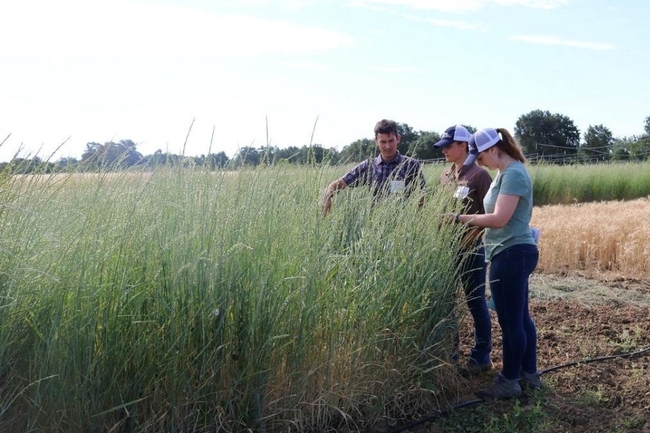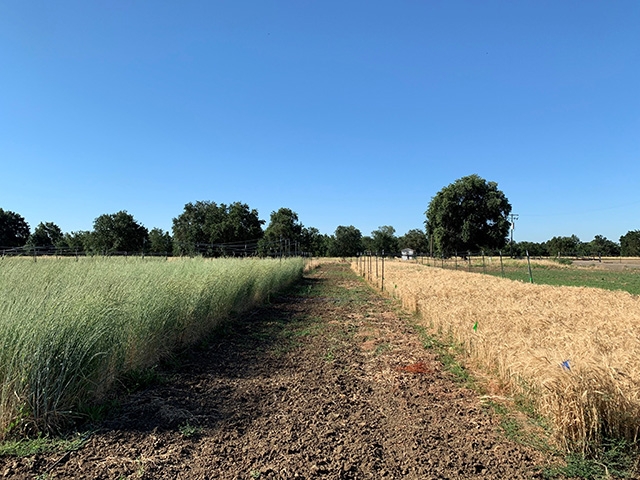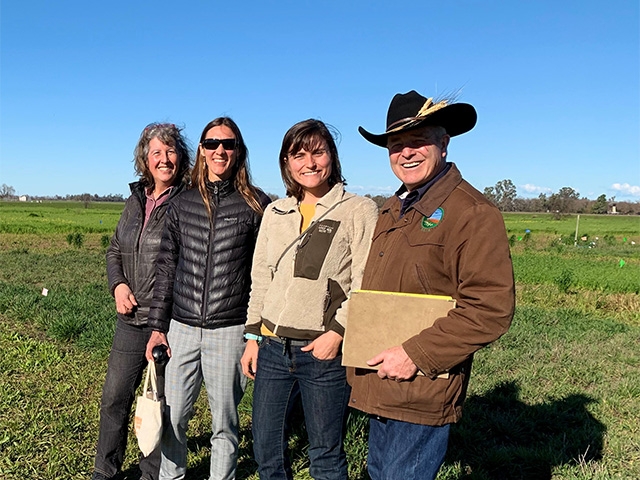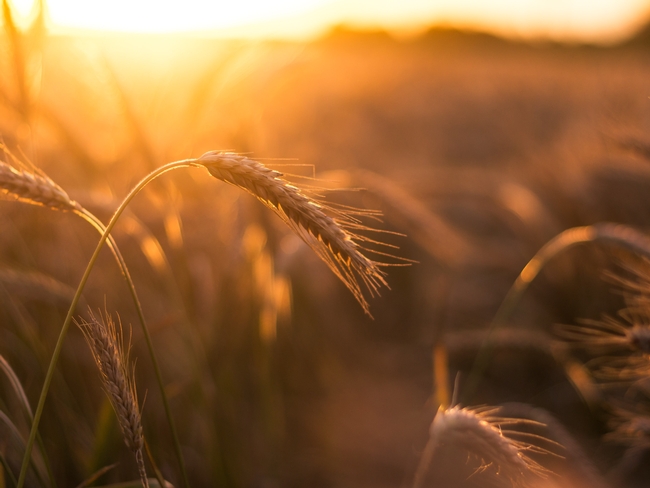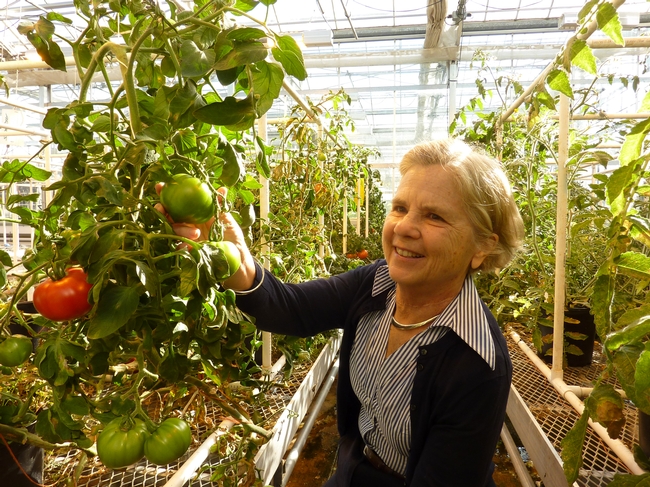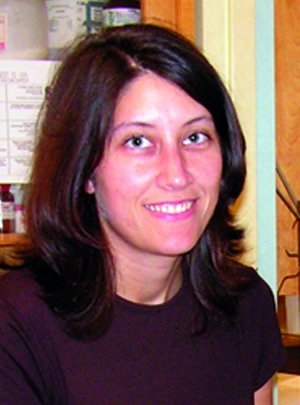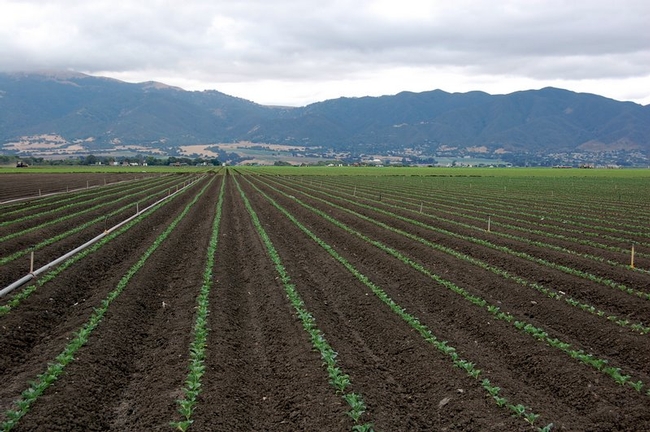Posts Tagged: plant sciences
No-till annual wheat better for soil health in California’s climate
One more reason to adopt sustainable cultivation
California wheat farmers could both maintain their yields and improve soil health by growing annual wheat without tilling the soil year after year.
This could be one more encouragement to farmers to adopt a sustainable practice commonly called conservation tillage, no-till or minimum-till cultivation, impacting how we grow a grain that supplies about 20 percent of the calories and protein for people around the world.
A new study, by a team led by Mark Lundy, University of California Cooperative Extension specialist in UC Davis' Department of Plant Sciences, offers new insight for decades-long discussions around soil conservation, sustainable agriculture and climate-warming emissions related to growing our food. The study has been published in the journal Soil and Tillage Research. For the first time, researchers have shown that annual wheat that is not tilled each year is better for stashing carbon in the soil than perennial wheatgrass, while still yielding more crop in Central California.
Previous studies have looked at annual wheat that is tilled each year, annual wheat that is not tilled, and a cousin species, perennial intermediate wheatgrass (trademarked Kernza), which also is not tilled. But until now, no one has looked at all of the benefits and trade-offs together. Most importantly, “no one has ever controlled for tillage,” Lundy said. “And, no one has compared annual wheat to perennial intermediate wheatgrass over multiple years in a Mediterranean climate, which is what we have in California.”
This study also is unique because it delves into the deeper question of what is going on in the soil that drives the different results for carbon there. Soil carbon reflects various processes linked to plant activity and soil health. Measuring the different forms of soil carbon may also signal whether a farming system is accumulating carbon in the soil over time – a plus for reducing climate-warming gases in the atmosphere.
“Measuring soil carbon is complex and nuanced,” said Kalyn Taylor, the lead author on the paper. “We started this experiment because we wanted to know whether and how plant activity and tilling or not tilling would affect the carbon story belowground in California's climate.”
“When we started this study, we thought the crop being perennial or annual would drive the differences in carbon storage in the soil,” Lundy added. Specifically, they had expected perennial wheatgrass would lead to more carbon in the soil because of its deeper, better-established root system. “But that's not what we found,” he went on. “What we found was, it was the lack of tillage, plus the level of productivity of common annual wheat, that made the difference in soil carbon here in California.”
Soil carbon in annual vs. perennial grain
In 2017, Lundy, then-graduate-student Taylor, UC Davis Professor Emeritus Kate Scow and others on the team started measuring different forms of soil carbon in test plots at Russell Ranch, west of campus. Plots were planted with annual wheat that was tilled each spring, annual wheat that was not tilled and perennial intermediate wheatgrass (Kernza) that also was not tilled.
Each year, the researchers measured the carbon present in the soil, the amount of soil organisms (which have carbon in their bodies) and the amount of material the plants created.
At the end of three growing seasons, they found that land planted with no-till, common, annual wheat had the highest amount of soil organisms, measured as biomass, of the three treatments.
The researchers also found soil carbon is more likely to remain stable in the no-till, annual plots, compared to both tilled wheat and wheatgrass.
In addition, the no-till, annual wheat produced plant material more consistently than the perennial wheatgrass across the three years, which saw variation in rainfall.
“Overall, annual wheat grown without soil disturbance or tillage had both higher productivity and higher potential for storing carbon in the topsoil than perennial wheatgrass in our Mediterranean climate,” Lundy said.
Related research
“No-till annual wheat increases plant productivity, soil microbial biomass, and soil carbon stabilization relative to intermediate wheatgrass in a Mediterranean climate,” is online now and will be published in the January 2024 edition of Soil and Tillage Research.
The team also found that tilled annual wheat vs. Kernza stores total carbon at different depths in the soil profile and hosts distinct soil fungal communities, primarily in the root zone and topsoil: Taylor, K., Samaddar, S., Schmidt, R., Lundy, M. and Scow, K., 2023. Soil carbon storage and compositional responses of soil microbial communities under perennial grain IWG vs. annual wheat. Soil Biology and Biochemistry, p.109111.
Previous work comparing the perennial grain known as intermediate wheatgrass (trademarked Kernza) to annual wheat had not distinguished the extent to which soil health benefits are a function of the perennial nature of the crop. Read the story here.
This story was originally published on the UC Davis News site.
UC Davis to lead $15 million research into climate-change resistant wheat
The project will also train plant breeders for the future
Wheat products account for roughly 20% of what people eat every day around the globe. As climate changes, wheat crops must adapt to new weather patterns to keep up with demand.
The University of California, Davis, is leading a five-year, $15 million research project to accelerate wheat breeding to meet those new climate realities, as well as to train a new generation of plant breeders.
“Everything is less stable,” said Jorge Dubcovsky, a plant sciences distinguished professor who is leading the grant research. “Everything is changing so you need to be fast. You need to be able to adapt fast.”
The grant from the U.S. Department of Agriculture's National Institute of Food and Agriculture will create a coordinated consortium of 41 wheat breeders and researchers from 22 institutions in 20 states. Researchers from Mexico and the United Kingdom are also participating.
Breeding needs to speed up
“Breeding crops for the future will require new traits, breeding platforms built for quick transfer of traits to elite cultivars, coordination of breeding efforts in public and private domains, and training for current and future plant breeders and researchers,” NIFA said in an announcement about this grant and others related to breeding.
The program involves on-the-ground research, identifying molecular markers and data analysis from multiple institutions to determine genes that will help wheat crops mitigate the effects of climate change. Plant breeding will follow to prove out those findings.
Wheat is unlike other crops in that 60% of the plant varieties — generating about $4 billion in annual production — are developed by public breeding programs rather than private corporations. In many states, wheat growers tax themselves to support basic breeding efforts at public institutions like UC Davis.
Increased coordinated research
The NIFA grant money will lead to more coordinated, sophisticated research. “This grant allows us to do breeding at a level that a good, modern company would do,” Dubcovsky said. “This grant is essential to maintain modern and effective public breeding programs in the U.S.”
The consortium will bring together data and research from across institutions, allowing for more expansive analysis while reducing redundancies. “We can take advantage of the data from everybody,” he said. “By doing that we don't need to duplicate efforts.”
A team in Texas will analyze plant images taken from drones at each institution to extract information about plant growth, water use, nitrogen levels and other data. “Using technology, we can see beyond our human capabilities,” Dubcovsky said. “You can extract a huge amount of information from every plant variety.”
The data from those images will allow researchers to document the plants throughout the life cycle and determine which plants fare better under certain conditions. Genotyping will help researchers obtain information about the plant genome. The combination of these two types of data could speed up breeding cycles, helping wheat crops adapt to a changing environment.
“If we can breed fast, we can adapt to change,” Dubcovsky said. “We are trying to make sustainable improvements in time.”
Training the next generation
The project will also train a cohort of 20 plant Ph.D. students in active breeding programs where they will participate in fieldwork, collect data from drones and DNA samples, and learn to integrate that information to accelerate wheat breeding. The students will participate in online and face-to-face workshops, as well as educational events and national scientific conferences.
Colorado State University, Cornell University, Kansas State University, Michigan State University, Montana State University, Oklahoma State University, Purdue University, South Dakota State University, Texas A&M University, University of Idaho, University of Illinois, University of Minnesota, University of Nebraska, University of Wisconsin, Utah State University, Virginia Tech, Washington State University, and U.S. Department of Agriculture Agricultural Research Service branches in North Dakota, Washington, Kansas and North Carolina are also participating in the consortium.
Discovery could deliver vintage flavor to a tomato near you
People often complain about grocery store tomatoes, saying they’re too hard and don’t have the flavor we remember from the days of old. And we thought we knew why - because the millions of tons of tomatoes harvested in the United States and beyond have to be picked before they’re fully ripe and juicy in order to survive being shipped long distances. What’s more, many shoppers store their tomatoes in the fridge, which destroys both their flavor and texture.
But guess what? It’s not just how tomatoes are grown, harvested and stored that affect their flavor. A research team led by Ann Powell, a biochemist in the UC Davis Department of Plant Sciences, has discovered a gene mutation that diminishes a tomato’s flavor even if the fruit is picked ripe and stored well. The finding, which was reported in the June 29 issue of the journal Science, identifies a gene that was unknowingly bred out of modern cultivated tomatoes and plays a vital role in producing the sugars and aromas that make heirloom tomatoes so tasty.
The news is unexpected and encouraging, because now breeders have the genetic information they need to create modern varieties suited for large-scale harvest and shipping with all the flavor of more delicate heirloom varieties.
“Now that we know that some of the qualities that people value in heirloom tomatoes can be made available in other types of tomatoes, farmers can have access to more varieties of tomatoes that produce well and also have desirable color and flavor traits,” Powell said.
It takes awhile to breed a new tomato variety, so don’t expect to taste the results anytime soon. But Powell and her team’s discovery is a huge first step. Tomato lovers can also be grateful for C.M. Rick Tomato Genetics Resource Center at UC Davis, home to a vast collection of mutant and wild species of tomatoes which provides the genetic diversity scientists and breeders need to recapture the flavor of old.
You can read more about the study here.
You can access the Science article here.
You can learn more about the C.M. Rick Tomato Resource Center here.
Unripe cantaloupe? Could be, the electronic nose knows
You know how it works: You stand in the grocery aisle, surreptitiously sniffing the cantaloupes, hoping your nose will lead you to a nice, ripe selection. But when you slice it open in your kitchen, it’s just not as ripe as you had hoped. Lucky for you (and me), UC Davis Department of Plant Sciences Assistant Professor Florence Negre-Zakharov and her team may have found a way to make imperfectly ripe fruit a thing of the past.
"We are involved in a project geared towards developing rapid methods to evaluate ripeness and flavor of fruits," explained Negre-Zakharov, who authored a paper on the method published in the March 30 edition of the Journal of Visualized Experiments (JoVE). "We evaluated an electronic nose to see if it can differentiate maturity of fruit, specifically melons. The goal is to develop a tool that can be used post-harvest to better evaluate produce, and develop better breeds."
When fruit ripens, it develops a characteristic volatile blend, indicating its maturity. Traditionally, the gold-standard of evaluating these volatiles has been gas chromatography, but it takes up to an hour to analyze a single sample, which makes it impractical to use outside the lab. Negre-Zakharov’s team wanted to determine if the much cruder — but much faster — electronic nose was able to determine if the melon they used in the experiment were ripe. It was.
"It’s quite encouraging technology for the purposes of determining maturity," she said.
"It's very impressive that the electronic nose system can do a type of gas chromatography in about a minute,” said JoVE science editor Zhao Chen. “Ultra-fast, indeed. Also, the sample preparation is as easy as making a smoothie at home. Such a user-friendly system could greatly help analysis efficiency in this field. Given the popularity of JoVE video-articles, I expect many researchers will know and adopt this method in their own research."
As a next step, the team is testing the electronic nose out in the field to see if it can still determine fruit maturity despite interference from all the background smells like soil and farm air. They hope to have results from those tests soon.
You can access a video of the study here.
UC Davis plant breeding: nurturing a rare breed
While working in Tanzania on community development projects several years ago, Iago Lowe came to a life-changing conclusion:
Food security is central to projects that make a lasting difference in people's well-being. It ensures that communities have the seeds, soil, water and environment to produce enough to eat.
However, his bachelor's degree in physics and religion from Dartmouth College did not adequately prepare him to spearhead those kinds of projects.
To address that gap in his ability to "make some small difference in the world," Lowe started doctoral studies at UC Davis in 2007 in plant breeding and genetics.
"There are so many needs in developing nations — for schools, roads, water, other infrastructure — but when the money and people leave, so often the projects die," said Lowe, who completed his Ph.D. in Plant Breeding and Genetics at UC Davis in 2011. "The few projects I saw that continued to thrive, that really made a tangible difference in people's lives, almost always dealt with local food security, seed systems, soil and water conservation and ecological restoration — projects that demanded a set of skills I didn't have. After studying plant breeding at UC Davis and that's no longer the case."
Lowe exemplifies a new breed of plant breeders at UC Davis. Long a global leader in plant breeding, UC Davis has been retooling its programs — offering new training, creating new curriculum, hiring new faculty (as the budget allows) and conducting world-class research to meet a growing demand for new crops and for breeders.
The new generation of scientists that those programs will produce — and their research breakthroughs — can't come soon enough for industry, government and philanthropic foundation leaders who say that a shortage of plant breeders is hampering efforts to alleviate hunger around the world. Hundreds of high-paying industry jobs for plant breeders are going unfilled.
“Plant breeding is such a vital tool for helping us deal with significant challenges in the 21st century such as food security, population increase, urbanization, and water and energy shortages," said Xingping Zhang, a watermelon breeder with the Davis-based seed company Syngenta. "Who is going to educate the plant breeders? UC Davis is in a perfect position to do so because it's a great center of science and technological inventions, located right in the heart of agricultural abundance. No place in the world offers the diversity of crops [like those] grown in California."
In another major nod to UC Davis expertise, the U.S. Department of Agriculture awarded $40 million in grants earlier in 2011 to develop climate-change-tolerant plants and new bioenergy sources. UC Davis scientists will lead two research teams from more than 50 universities in more than 20 states.
"Each of these projects features transdisciplinary, regional, integrated teams, including scientists from institutions that represent underserved populations," said Roger Beachy, director of the USDA's National Institute of Food and Agriculture, in announcing the grants at UC Davis. "This approach represents a new paradigm in how USDA science can best solve critical issues facing agriculture today."
You can read more about the history and future of plant breeding at UC Davis in this article in the UC Davis Magazine.
Learn more:
UC Davis plant breeding education
Story on UC Davis Department of Plant Sciences website
Seed Biotechnology Center videos on plant breeding


